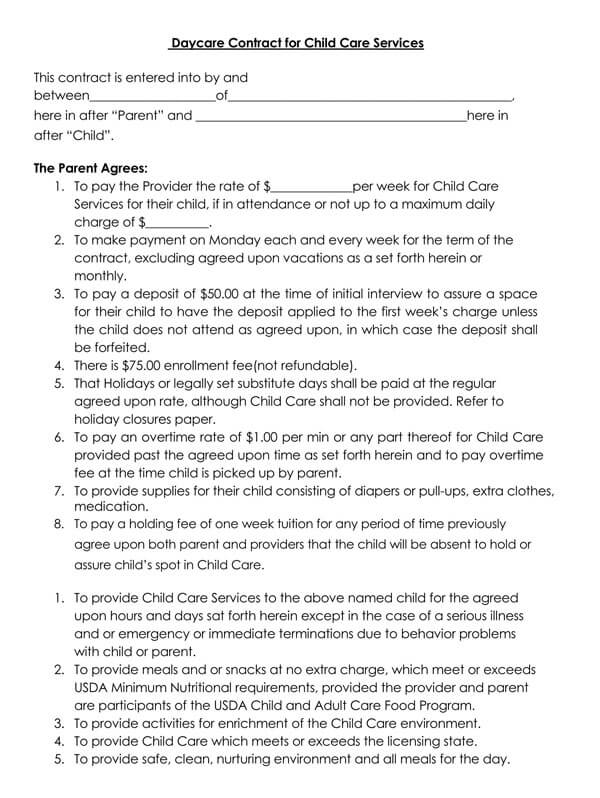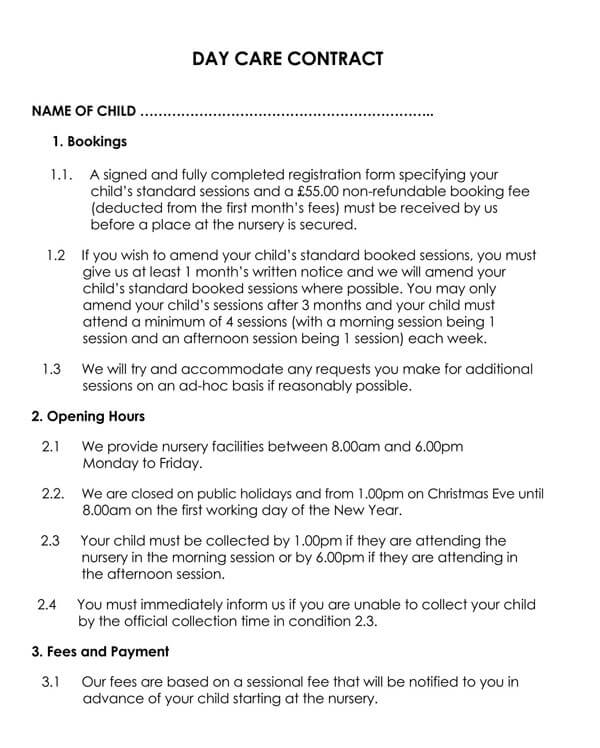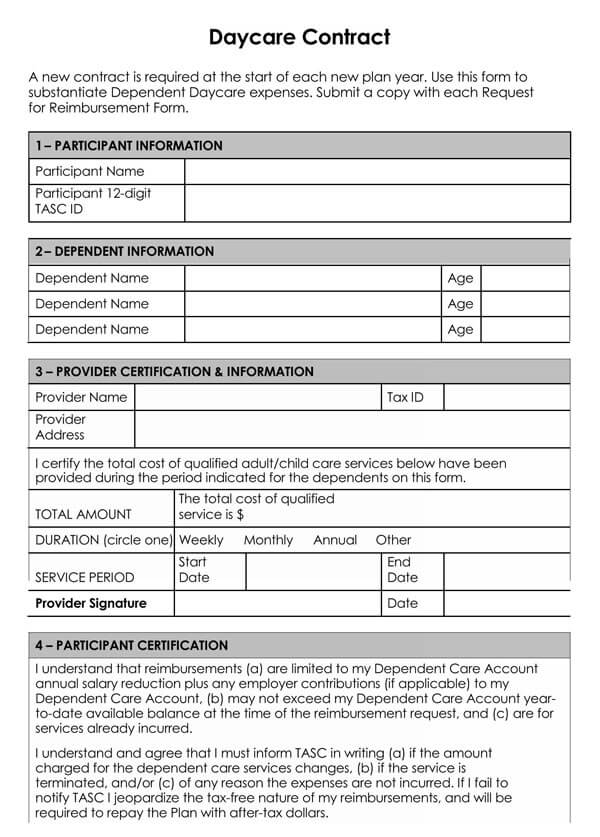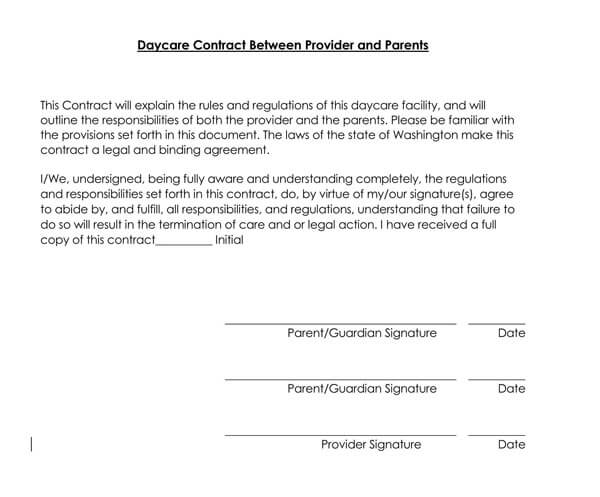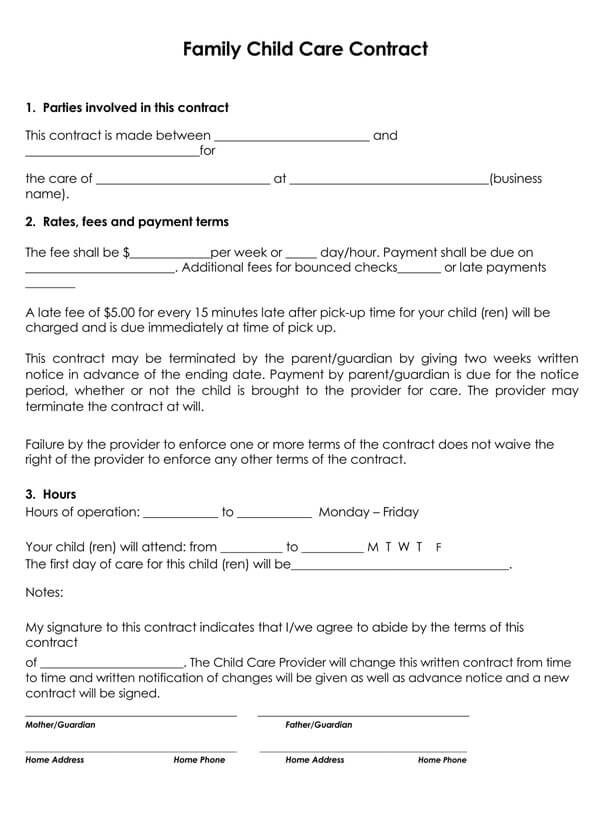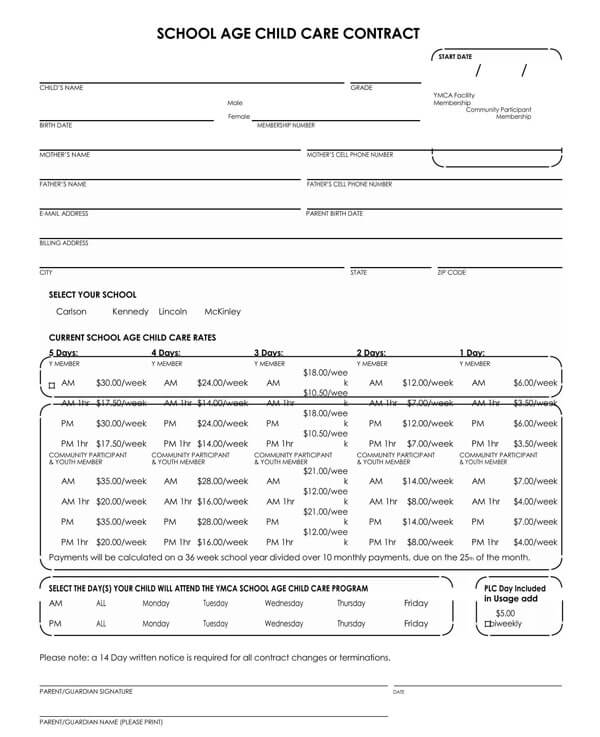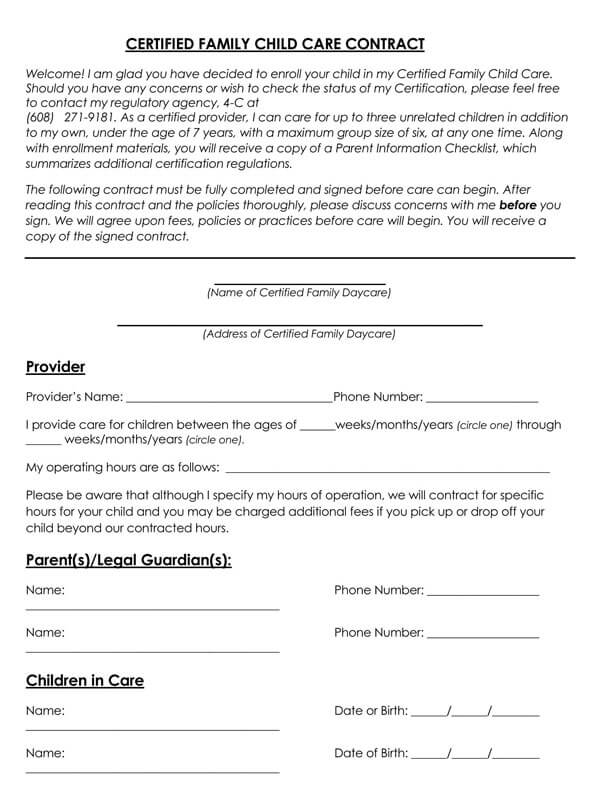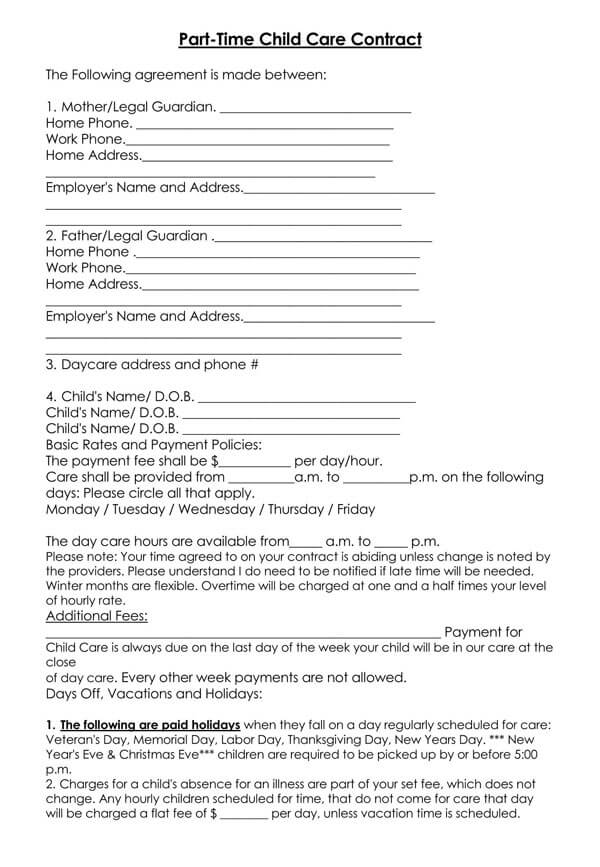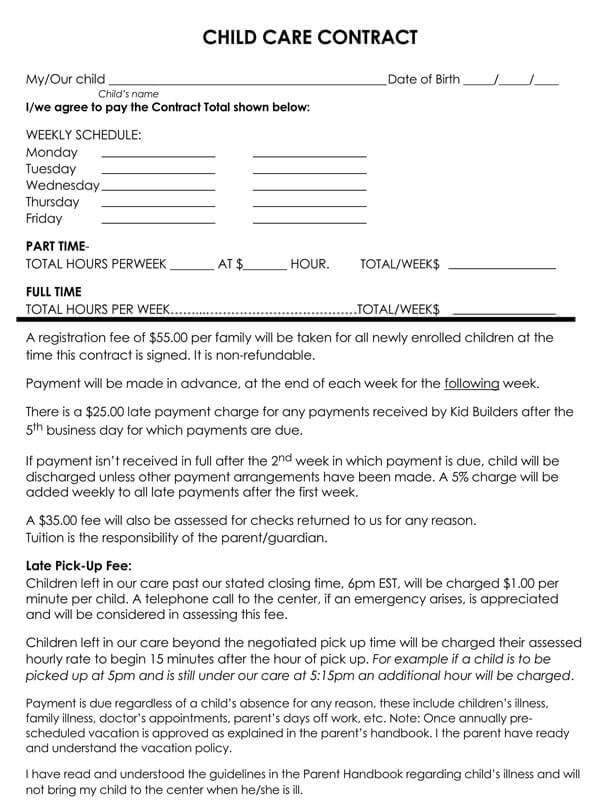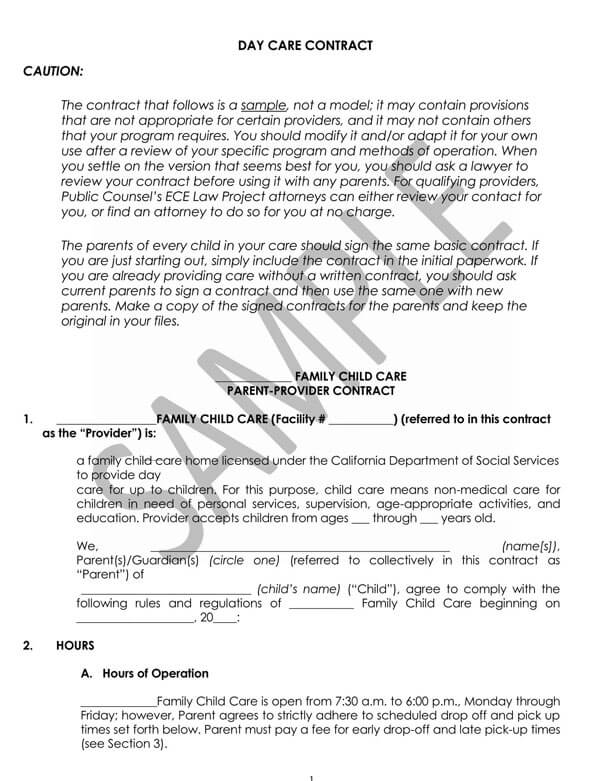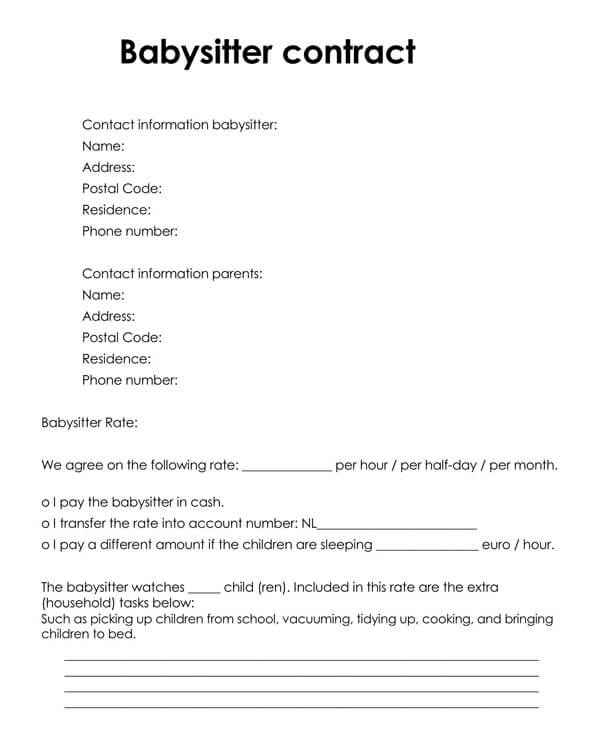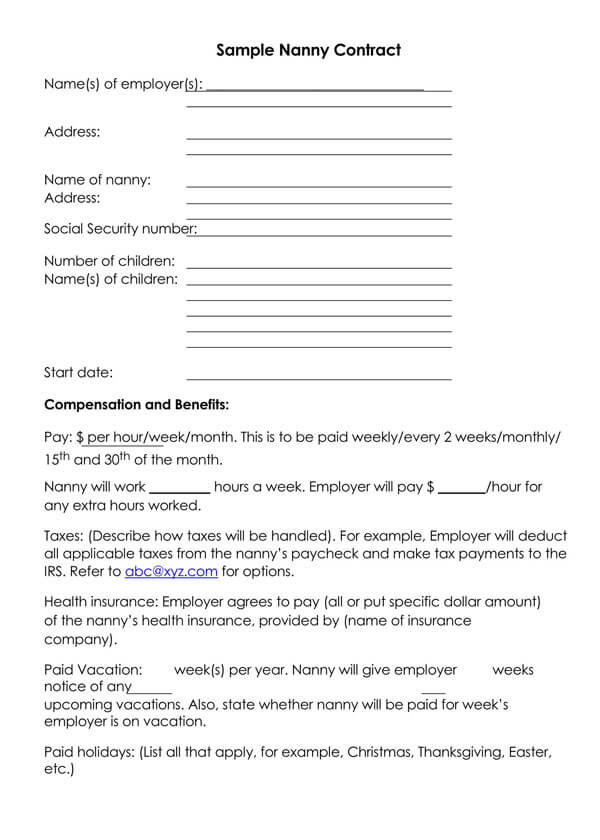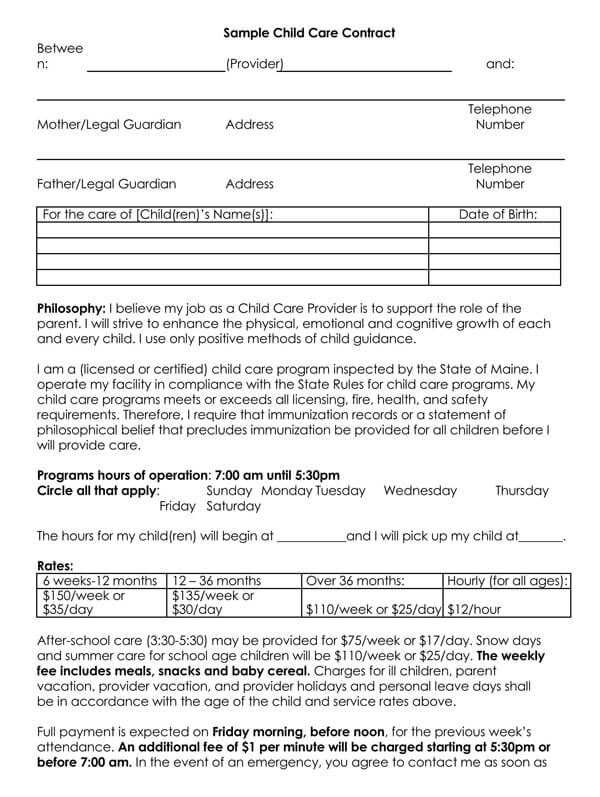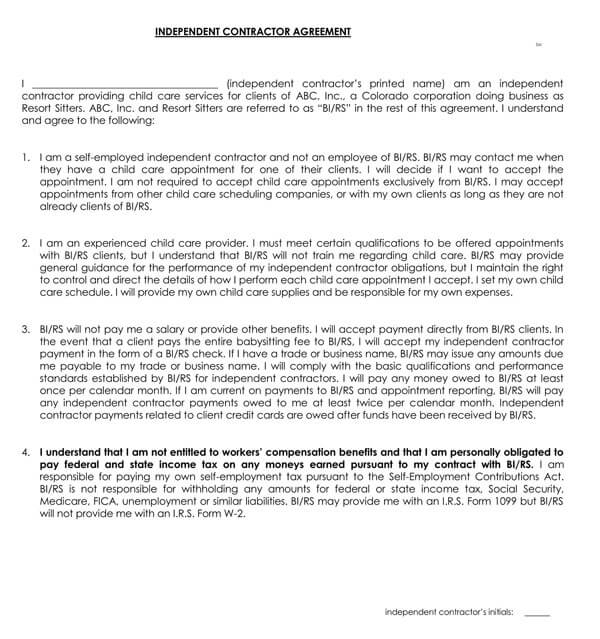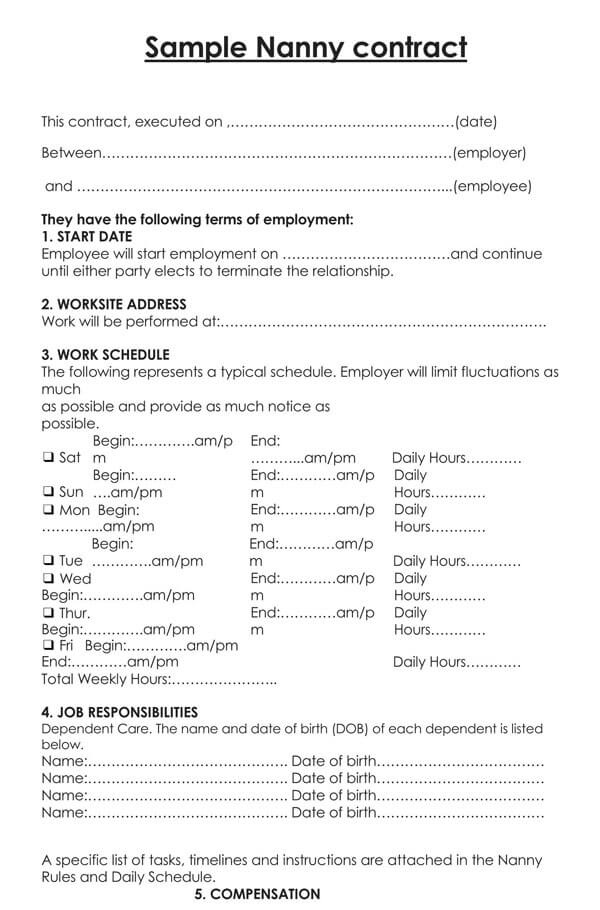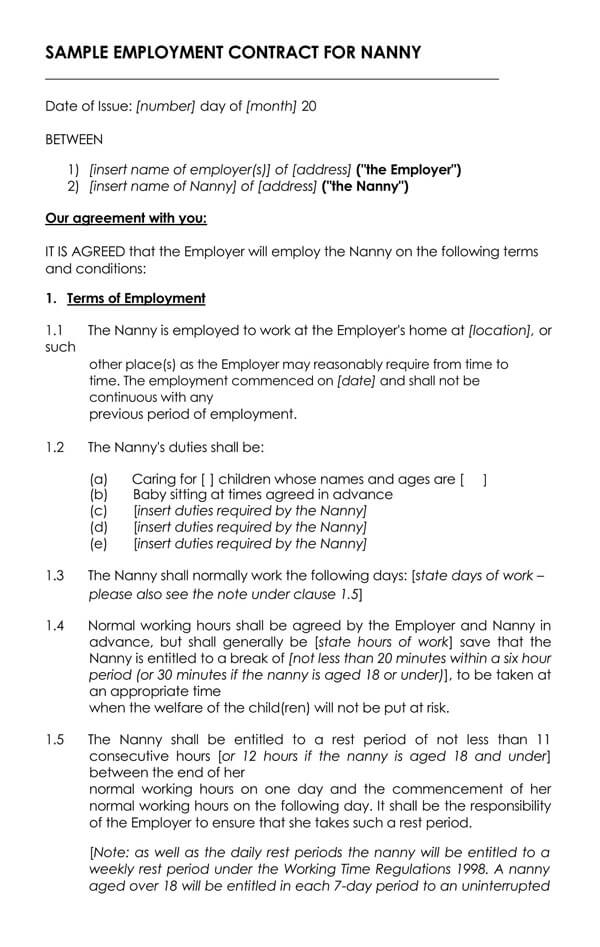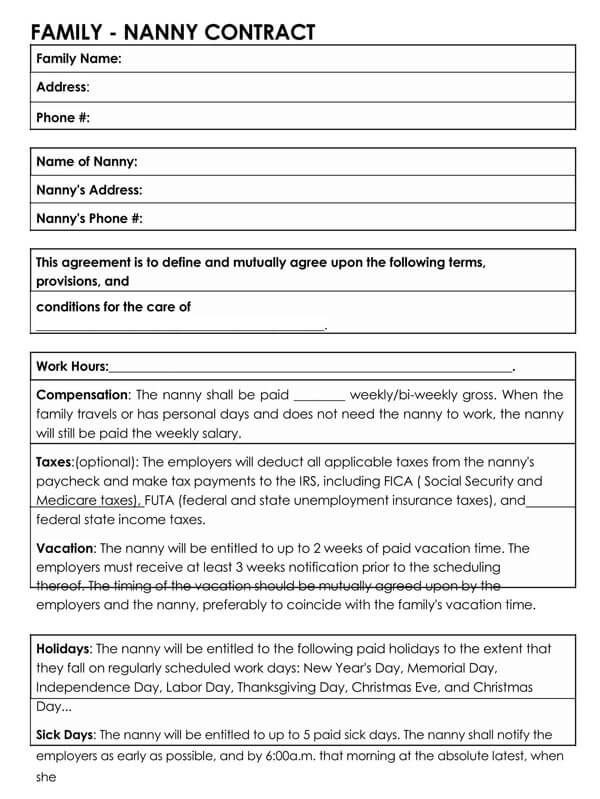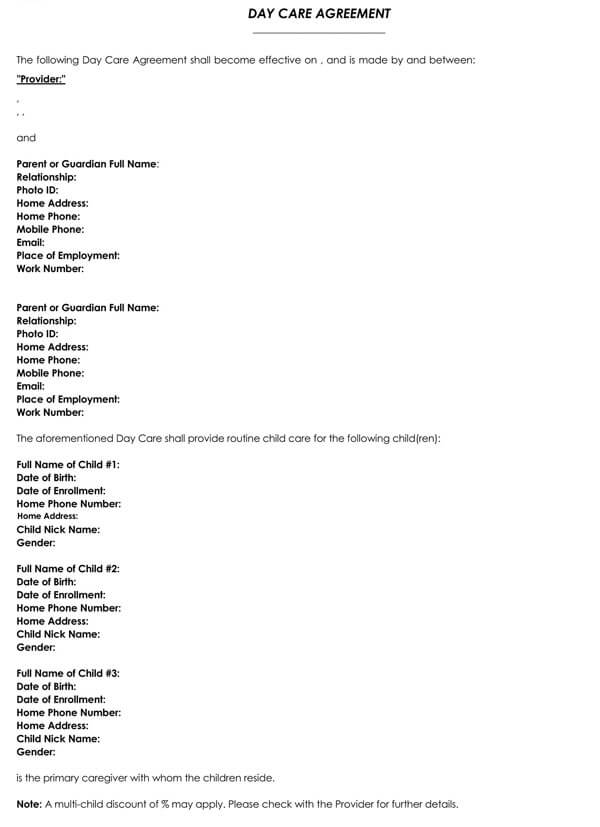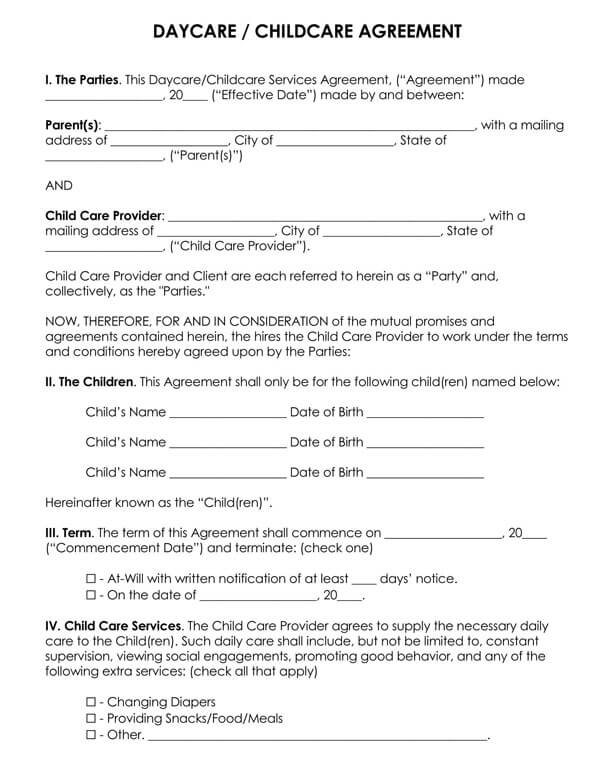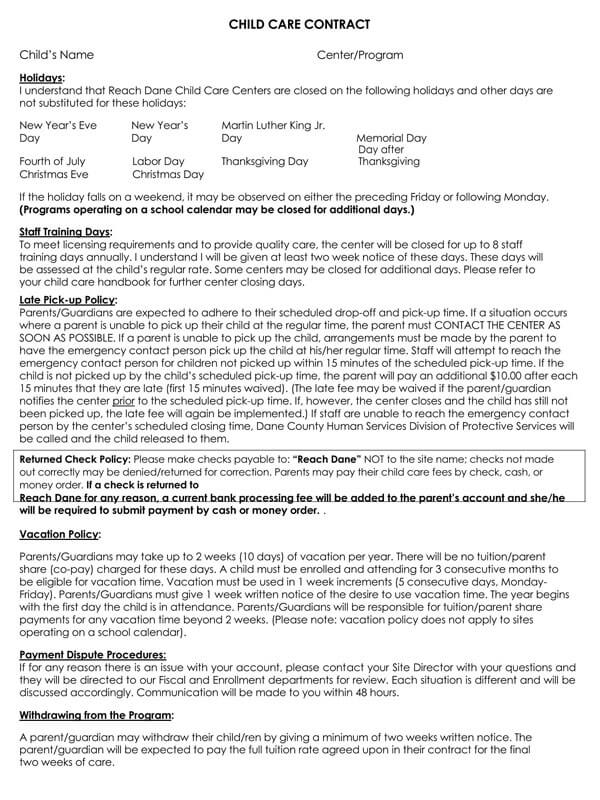A Daycare Contract is an agreement between a parent (client) and a child care provider outlining the terms and conditions under which child care services will be provided for the parent. It is also referred to as any one of the following; child care services agreement, child care contract, babysitter agreement, babysitter contract, daycare contract, or nanny contract.
What is the Purpose of a Child Care Contract?
A child care contract or agreement outlines the specifics that the provider and the parent have agreed on to ensure they understand their obligations in this agreement. More than that, it aims to protect the parent, daycare provider, and the child.
Some of the particulars addressed in a daycare contract include;
- Specifics of the child care services such time, meals, activities, etc.
- Payment details such as amount, date expected, and modes of payment. A breakdown can be included to justify the amount.
- How are any expenses to be handled, will there be a notice and such? How reimbursed is to be carried out.
- Any facilities such as a vehicle, gaming equipment, etc., available to the provider can be used to improve child care quality.
- A confidentiality clause that limits the provider from disclosing the child’s or parents’ confidential information to others.
- The standard of care the provider is expected to maintain and provide for the child.
- It contains a limitation of liability clause that limits the number of potential damages and lawsuits the service provider would face, depending on the situation at hand.
- A child care contract can be legally binding, and both parties should carefully review the contract before agreeing to it. Seeking legal counsel when preparing a contract is important is recommended.
Who Should Use a Child Care Contract?
It is used by individuals or organizations that want to provide or seek child care services. It is used to protect the provider and the client and ensure that quality child care is provided to the child. It binds the two parties and outlines the responsibilities that each party is expected to fulfill.
Examples include;
- Parents /guardians are seeking child care services from any child care provider. A contract helps them understand what they are paying for in terms of services being provided and gives them authority to demand compensation should the provider fail to keep their word.
- Individuals in the child care profession such as nannies or babysitters. A contract shows the services they offer and protects them from being overexploited.
- Organizations such as schools, gyms, companies that provide child care services for their employees or clients. A child care contract protects such establishments from being sued for anything other than the obligations outlined in the contract.
Different Types of Day Care
There are different types of daycare, and they vary depending on the parents’ needs.
Here are the various types of daycare a provider can choose to offer
24-Hour: Child care that is provided for a child who is to stay overnight.
Center-based: It is also referred to as commercial daycare. A child is dropped off at a facility where they are looked after as a group. Center-based daycares have multiple caregivers.
Gym: Provided for parents who want to work out in the gym and have their children taken care of and entertained in the meantime.
Home Based: This is daycare given at the provider’s place of residence. Usually, this is where there are more than four children.
Infant/Toddler: This is a daycare provided for children from birth to three years. Usually requires more money to cater to all the child’s needs.
How to Write a Daycare Contract
To ensure that you communicate what is needed in a child care contract and do so effectively. Here are the various steps you can follow when preparing a daycare contract :
The date of signing
The first thing is to include the date when this agreement was made. It is provided at the topmost part of the contract.
The names of the parties
The next thing one should do is include the name of the two parties bound by the contract, the parent and the child care provider in this case.
The child’s name
The name of the child should also be included as for center-based child care; there are multiple children. It is good to link the parent/guardian to the child.
Exact services required and any special needs
This should be followed by the services the parent and the guardian have agreed that the child should be provided. This section in the daycare contract can include a little training, coaching, sports, and any extra activities.
Days and times that the child will attend
The next part is to specify the date on which the said services will be provided and the exact timelines. Both parties (parent and provider) are expected to adhere to these timelines.
Payment amount, method, and frequency
Payment rate and schedule: The payment rate gives the hourly, daily, weekly, or monthly payment rate, and the schedule stipulates when the parent is expected to make payments say after two weeks or monthly.
Overtime rates, late fees: Should the provider have to care for the child longer than the stipulated time, they should be compensated, and the billing rates for overtime should be declared here.
Any additional fees: A payment plan for additional fees for things like stationery, breakages, etc., incurred should be given in the contract.
Deposits: Suppose a deposit is required before the provider admits the child; it should be pointed out in this section.
Signature of both parties
To formalize the contract, both parties should sign at the end of the contract.
Termination procedure
Termination procedures section in a daycare contract include;
- Provider’s right to end arrangement for any reason with a specified period of notice
- A statement requiring payment during the termination period, regardless of the child’s attendance.
- Provider’s right to terminate care without notice if a parent misses payments
- Additional information: Notice for vacation etc., you should indicate holidays, and days the dare care is not operational.
How Should Compensation be Handled in the Daycare Contract ?
A child care provider can be compensated in different ways. The amount can be fixed or varied depending on the time period.
Therefore, compensation should be declared by giving the following information:
Billing rates
The billing rates are often given as hourly, weekly, or monthly, and how much does it cost. This is influenced by the type and dynamic of services being provided. For example, a daycare where extra training or learning is being offered is expected to be more expensive than where such services aren’t being offered.
Associated taxes and interests
Taxes are determined by the location of the daycare, which can vary from state to state, where else interests, which could be from late payments, can be influenced by how late they are, the amount expected, and such.
Duration of payment
The duration of payment which, in most cases, is dependent upon the child care contract between the provider and the client or daycare payment policies.
Down payment
In some instances, a deposit is expected; for example, where there are children’s necessities to be bought, a provider would request to be compensated beforehand.
Additional Compensation
Any additional compensation needed should be declared. This is often done to highlight ways to deal with breakages or expenses on the provider’s side that were not part of the child care contract Modes of payment are usually in terms of cash, cheques, etc. – this, in most cases, is at the provider’s convenience, especially for center-based daycare.
Day Care Contract Templates
Crafting a child care contract from scratch every time one is needed can be involving especially for beginners. That is why to ease the workload for you, we have provided free child care contract templates you can download and customize to fit your needs. They are up to standard and easy to use.
Note
For a daycare to be operating, it must be licensed and registered by the state. To be issued a license, a child care provider must meet the building and safety codes and the set minimum number of adults per child allowable. Daycares are regulated by the state’s childcare administration office. Daycares are also subjected to state laws and local laws.
How much is Day Care?
The cost of daycare varies with type, state, and other factors. However, on average, a parent parts with a$1230 for center-based and $800 for home-based daycare calculated with a 25 hours per week timeline.
Is daycare cheaper than a Nanny
Ordinarily, yes. Daycare is cheaper than a nanny considering the average wage for a nanny is around $19 per hour.
Day Care cost vs. Nanny Cost
Using the billing rates given above, through calculation, the wages for a nanny working 25 hours a week for four weeks ( month) will be $1900 per month. This is $670 more than center-based daycare and $1100 more than home-based daycare.
Is Daycare Tax-Deductible?
Yes, for parents with children below the age of thirteen. As a parent, you are qualified for tax deductions of up to $1050 for a single parent/guardian and $2100 for both parents/guardians. The age limit is applicable unless the child has any physical or mental disabilities.
IRS Form 2441– is a form provided to assist parents in carrying out their calculations when filing for returns. It stipulates under which tax bracket their earnings fall.
Tax Calculation
The tax deductions are calculated as a percentage of the parent’s earnings, and the maximum allowable is 35%, of $3000 per parent.
Tax deductions can be calculated as follows:
- $0 to $15,000: 35%
- $15,000 to $17,000: 34%
- $17,000 to $19,000: 33%
- $19,000 to $21,000: 32%
- $21,000 to $23,000: 31%
- $23,000 to $25,000: 30%
- $25,000 to $27,000: 29%
- $27,000 to $29,000: 28%
- $29,000 to $31,000: 27%
- $31,000 to $33,000: 26%
- $33,000 to $35,000: 25%
- $35,000 to $37,000: 24%
- $37,000 to $39,000: 23%
- $39,000 to $41,000: 22%
- $41,000 to $43,000: 21%
- $43,000+: 20%
Example Tax Calculation
For a single parent earning $20000 a year, the tax deduction will be 32% of $3000 which amounts to $960.
Home-based vs. Center-based day-care
For anyone seeking or providing child care services, there are two general approaches they can take either home-based or center-based daycare.
Some of the distinguishing factors include;
Affordability
Home-based daycare is often more affordable than center-based daycare in terms of payments, overtime rates, late payment fees, etc.
Number of children
There are more children in a center-based than a home-based daycare. This is because, in a center-based daycare, it is possible to hire more staff to increase the adult per children ratio than in a home-based. This, however, reduces the attention each child gets, which might be a point of consideration.
Flexibility of hours
Home-based daycares usually operate on flexible hours, which can be very convenient for attracting parents or guardians, unlike in a center-based daycare where operating hours are strict.
On top of these differences, it is important to note that additional services like learning can be provided in a center-based daycare, and it is required to have skilled staff regarding medical emergencies, whereas else in a home-based daycare, this is entirely on the service provider.
Babysitting Contract vs. Nanny Contract
Other contracts that may at some point be necessary are a babysitting contract and a nanny contract. A babysitting contract is used to hire a babysitter to look after the children on a temporary basis, while a nanny contract is used to acquire the services of a nanny to be looking after the children on a long-term basis.
Other documents relevant to child care are;
Child Travel Consent: Used to request permission from the parent to travel with their child in their absence.
Child Medical Consent: Grants the care provider consent to medical emergencies in the parents’ absence.
Contract Addendum: Alterations made in an existing contract instead of drafting a new one.
Invoice Form: Bill issued by the provider for services rendered.
A child care contract is an important document in the child care industry. Writing one might not be enough if it is not written well. There are many uncertainties associated with taking care of children, and a well-written child care contract can be utilized in a court of law to show failure on either party’s side. Therefore, it is advisable to state how far a provider’s responsibilities go. Ensure that you understand the laws associated with child care services before drafting a child care contract. The steps and information that have been provided in this article will go a long way in assisting you with the process.
Frequently Asked Questions
What do I need to bring with me to sign-up for child care?
Several documents are required, such as a health certificate, original copy of the approved building, a business plan, municipal licensing permit, criminal records clearance, licensing clearance, and insurance.
What is the difference between a childcare center and family child care?
A childcare center provides care for a larger group than a family child care, and it operates outside a private home, unlike family childcare.
